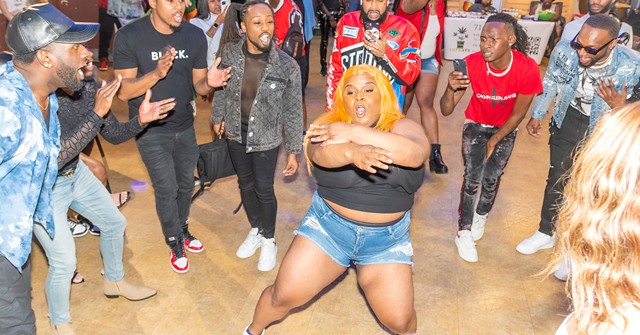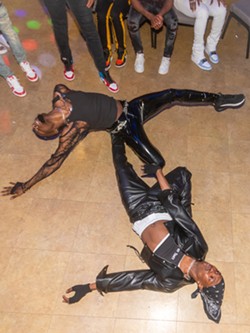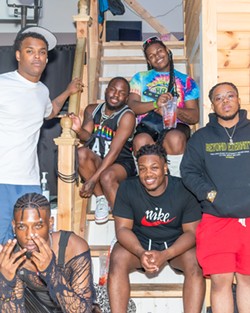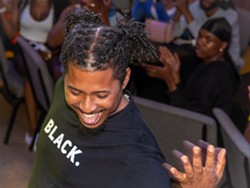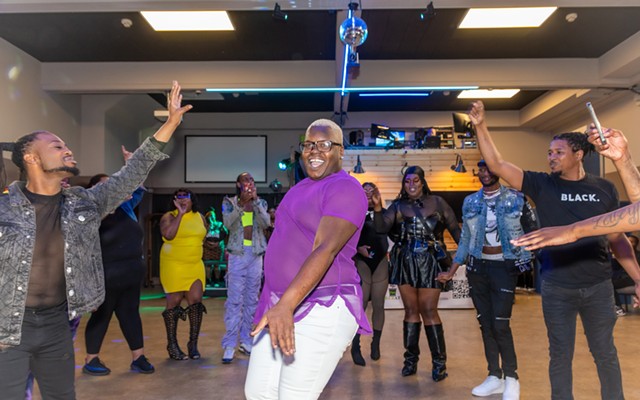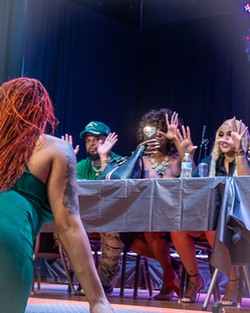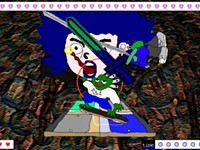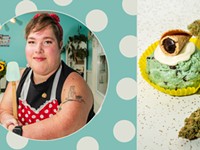[
{
"name": "500x250 Ad",
"insertPoint": "5",
"component": "15667920",
"parentWrapperClass": "",
"requiredCountToDisplay": "1"
}
]
It’s a Saturday night in Rochester and inside 75 Stutson Street, a former church-turned-event space, roughly 100 people are clapping and chanting. Ballroom music is blasting from the dimly lit space, but it’s not the waltzing kind — here, the people are voguing.
“You can’t f*ck with this! It’s Fendi, bitch!”
Welcome to the Black Excellence Juneteenth Kiki Ball, emceed by Ballroom legend Precious Old Navy.
“Sometimes people come to balls and think it's just about voguing,” she said. “It's about runway. It's about self-expression. It's about safe spaces.”
Voguing, in this case, refers to highly stylized house dance that evolved in the late 1980s from the Harlem Ballroom scene of the 1960s. The Ballroom scene is a predominantly Black and Hispanic underground LGBTQ+ subculture which originated in New York City during the late twentieth century, when the HIV/AIDS epidemic was almost exclusively perceived as a disease within the gay community. Individuals within this community were shunned by their families and blacklisted by society because of the unknowns and the fear of transmission.
“You were tossed to the street, you were disowned,” said Chasmar Aponte, who has been a major player in the Western New York Ballroom culture for decades.
This feeling of exile forced LGBTQ+ persons to create “safe spaces” in retaliation to the hate that was met above ground. It was at these balls they were able to freely showcase their true selves through pageantry, fashion and dance. But it’s the competitive nature of the events that transcends it all.
“That's where you get most of the fame when it comes to Ballroom,” said Aponte.
At the Balls, groups referred to as “houses” compete for money and bragging rights on a Mainstream stage or on the Kiki (a more amateur) level. Houses originated as actual homes where kids who were shunned by their families due to disease or lifestyle would be taken in and offered a place to live. The house was run by a gay mother and father. Because it was more difficult for LGBTQ+ identifying people to get jobs in the late 70’s and early 80’s, the money won at balls were used to maintain the home by paying bills and buying groceries.
“So, you would go to these balls and really show out,” said Aponte. “Nowadays, you're not really paying to live anywhere, instead you’re getting bragging rights and notoriety.”
But the hierarchy system of Mainstream and Kiki remains. On the Mainstream scene, Aponte is a child for the House of Balmain, but on the local Kiki scene he is the overall father of the House of Fendi, where he nurtures 18 kids.
“I pretty much teach the youth how to be a part of the Mainstream scene, and I actually guide some of them into the Mainstream scene,” said Aponte, who also tutors and offers ballroom lessons at Trillium Health’s MOCHA Center. “I like to put my kids in a place where they can create their own legacy and live as free as I do.”
At Saturday night’s Kiki Ball, Aponte’s house was the most dominant in size and accomplishment, taking home most of the prize money.
“You can’t f*ck with this! It’s Fendi, bitch!”
Event curator Nyk Tyrell is new to the Ballroom scene but was once a child of Aponte’s House of Fendi. He has branched off and is now the mother of his own house with a mission of growing and legitimizing the Kiki Ballroom scene in Western New York.
“I believe in what we have here, and I believe that we can do a lot,” said Tyrell, who goes by ‘Symphony’ on the Ballroom scene. “I want to start something here that's everlasting. Something that really gives the ballroom community a bigger platform.”
Together, Tyrell and Aponte have launched the Western New York Ballroom Alliance, a non-profit dedicated to ensuring the region gets the recognition they feel it deserves.
“I'm really excited about where Ballroom is, and where Ballroom is going for this region,” said Tyrell.
The next Kiki Ball will be held August 12 (location TBA). Stay updated through The Western New York Ballroom Alliance Inc. page on Facebook.
Racquel Stephen is a reporter at WXXI. She can be reached at [email protected].
“You can’t f*ck with this! It’s Fendi, bitch!”
Welcome to the Black Excellence Juneteenth Kiki Ball, emceed by Ballroom legend Precious Old Navy.
“Sometimes people come to balls and think it's just about voguing,” she said. “It's about runway. It's about self-expression. It's about safe spaces.”
Voguing, in this case, refers to highly stylized house dance that evolved in the late 1980s from the Harlem Ballroom scene of the 1960s. The Ballroom scene is a predominantly Black and Hispanic underground LGBTQ+ subculture which originated in New York City during the late twentieth century, when the HIV/AIDS epidemic was almost exclusively perceived as a disease within the gay community. Individuals within this community were shunned by their families and blacklisted by society because of the unknowns and the fear of transmission.
“You were tossed to the street, you were disowned,” said Chasmar Aponte, who has been a major player in the Western New York Ballroom culture for decades.
This feeling of exile forced LGBTQ+ persons to create “safe spaces” in retaliation to the hate that was met above ground. It was at these balls they were able to freely showcase their true selves through pageantry, fashion and dance. But it’s the competitive nature of the events that transcends it all.
“That's where you get most of the fame when it comes to Ballroom,” said Aponte.
At the Balls, groups referred to as “houses” compete for money and bragging rights on a Mainstream stage or on the Kiki (a more amateur) level. Houses originated as actual homes where kids who were shunned by their families due to disease or lifestyle would be taken in and offered a place to live. The house was run by a gay mother and father. Because it was more difficult for LGBTQ+ identifying people to get jobs in the late 70’s and early 80’s, the money won at balls were used to maintain the home by paying bills and buying groceries.
“So, you would go to these balls and really show out,” said Aponte. “Nowadays, you're not really paying to live anywhere, instead you’re getting bragging rights and notoriety.”
But the hierarchy system of Mainstream and Kiki remains. On the Mainstream scene, Aponte is a child for the House of Balmain, but on the local Kiki scene he is the overall father of the House of Fendi, where he nurtures 18 kids.
“I pretty much teach the youth how to be a part of the Mainstream scene, and I actually guide some of them into the Mainstream scene,” said Aponte, who also tutors and offers ballroom lessons at Trillium Health’s MOCHA Center. “I like to put my kids in a place where they can create their own legacy and live as free as I do.”
At Saturday night’s Kiki Ball, Aponte’s house was the most dominant in size and accomplishment, taking home most of the prize money.
“You can’t f*ck with this! It’s Fendi, bitch!”
Event curator Nyk Tyrell is new to the Ballroom scene but was once a child of Aponte’s House of Fendi. He has branched off and is now the mother of his own house with a mission of growing and legitimizing the Kiki Ballroom scene in Western New York.
“I believe in what we have here, and I believe that we can do a lot,” said Tyrell, who goes by ‘Symphony’ on the Ballroom scene. “I want to start something here that's everlasting. Something that really gives the ballroom community a bigger platform.”
Together, Tyrell and Aponte have launched the Western New York Ballroom Alliance, a non-profit dedicated to ensuring the region gets the recognition they feel it deserves.
“I'm really excited about where Ballroom is, and where Ballroom is going for this region,” said Tyrell.
The next Kiki Ball will be held August 12 (location TBA). Stay updated through The Western New York Ballroom Alliance Inc. page on Facebook.
Racquel Stephen is a reporter at WXXI. She can be reached at [email protected].
Latest in Culture
More by Racquel Stephen
-

American Puffalo
Mar 29, 2024 - More »
